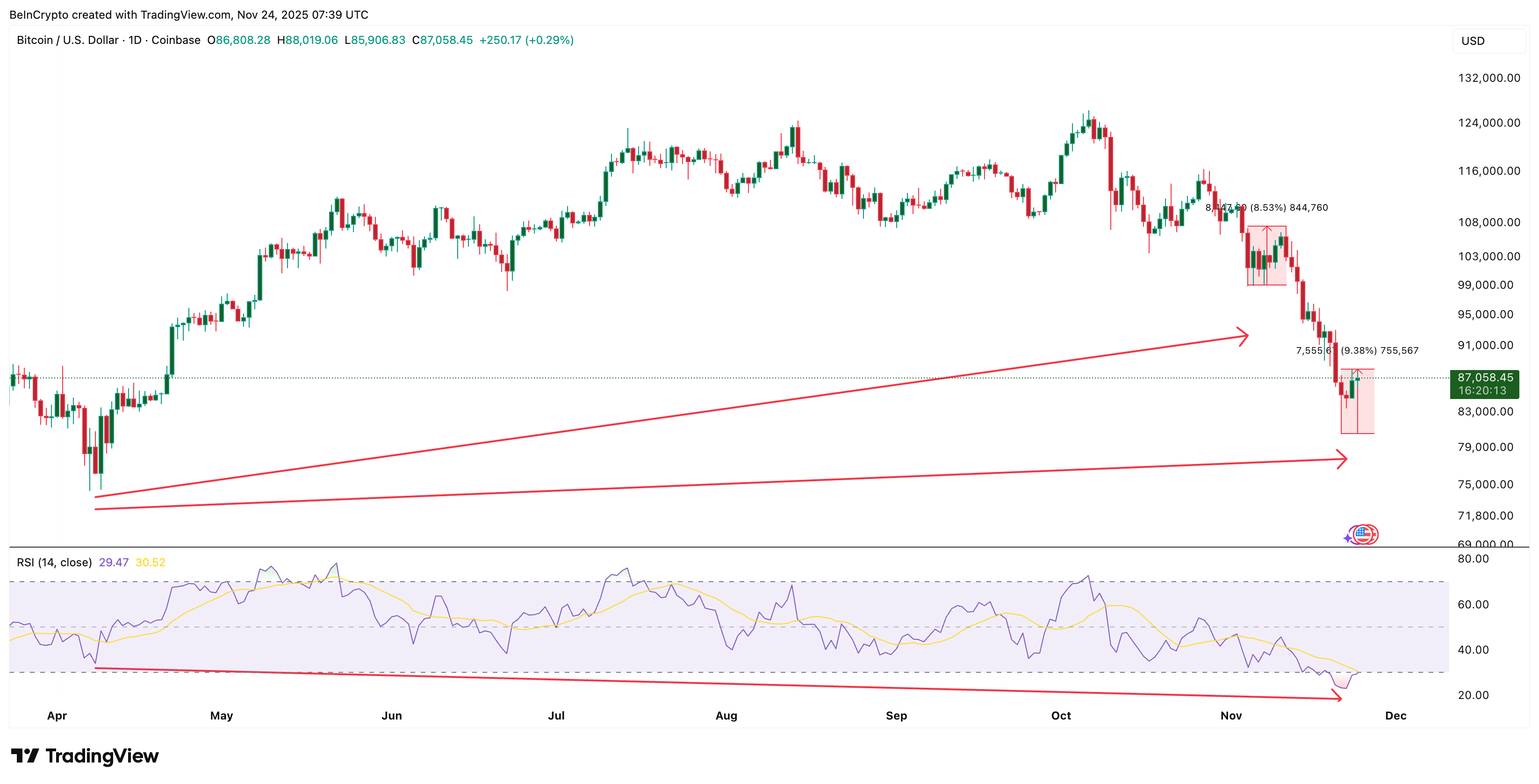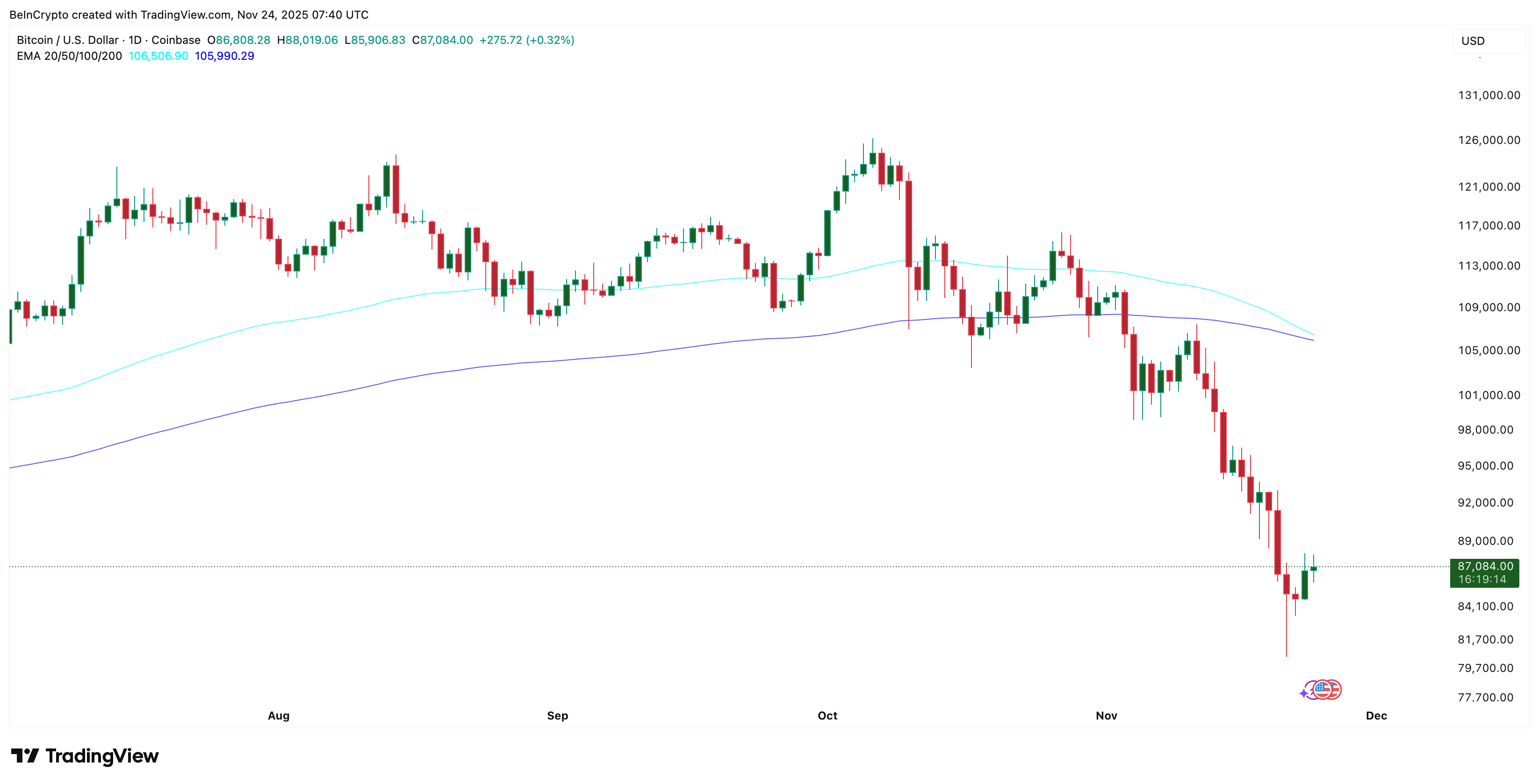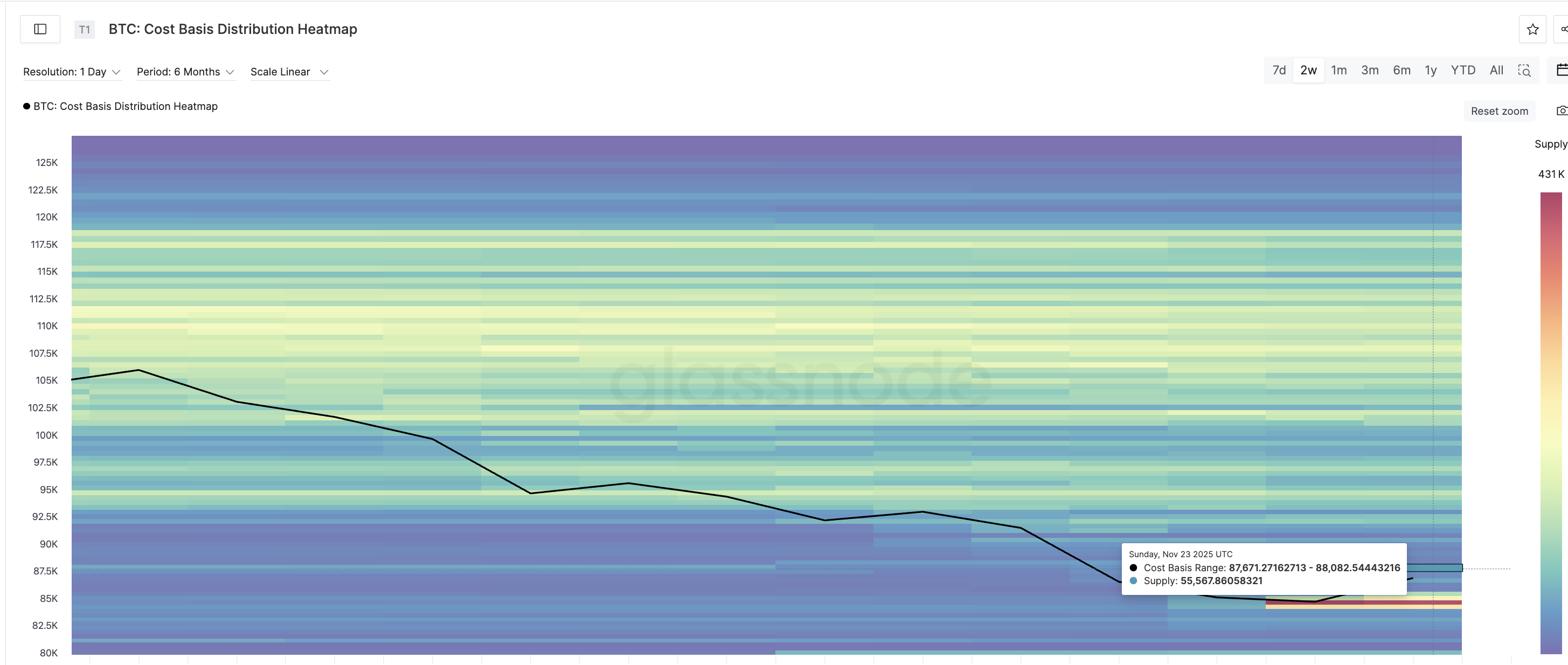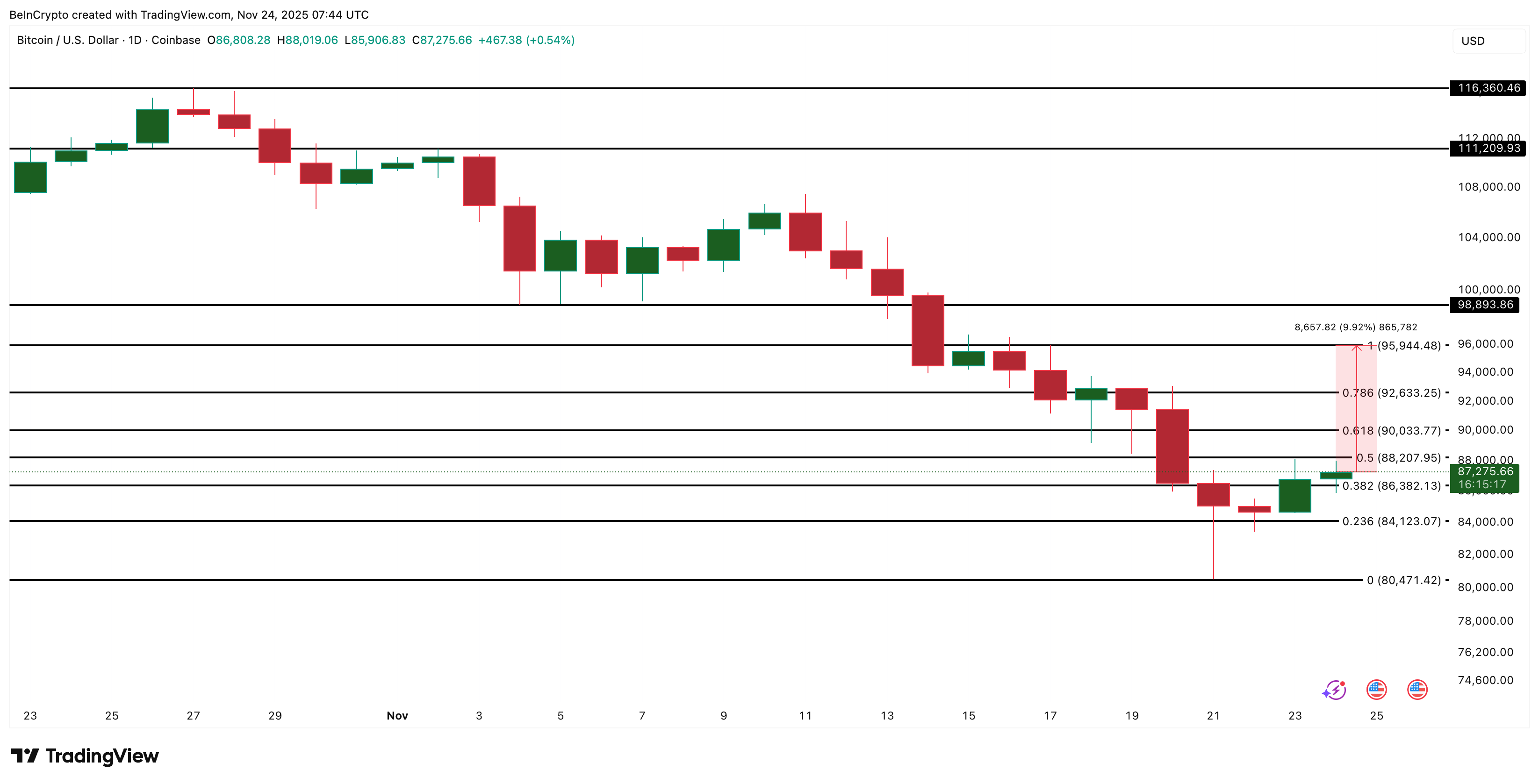Bitcoin’s 9% Bounce Faces a Bearish Wall — Why Moving Past $88,000 Becomes Critical Now?
Bitcoin price is up about 2% today and has already gained almost 9.4% from this week’s lows near $80,400. The move looks solid, and the rebound was expected because of a technical signal that has worked before. But a major risk is building at the same time, near a key level. It could decide whether
Bitcoin price is up about 2% today and has already gained almost 9.4% from this week’s lows near $80,400. The move looks solid, and the rebound was expected because of a technical signal that has worked before.
But a major risk is building at the same time, near a key level. It could decide whether this bounce continues or fails at the next barrier.
Why The Bounce Happened — And What Could Cap It Next
The first sign came from momentum.
Between April 8 and November 22, Bitcoin’s price made a higher low, but the Relative Strength Index (RSI) made a lower low. RSI measures whether momentum is rising or falling by comparing recent gains and losses. This pattern is called hidden bullish divergence. It shows sellers losing strength even while the chart looks weak.
The same setup appeared between April 8 and October 26, and that move created an 8.53% rebound. This time, Bitcoin has already climbed 9.38%, which means the signal played out again.
Want more token insights like this? Sign up for Editor Harsh Notariya’s Daily Crypto Newsletter
 Bitcoin’s Rebound Was Expected:
Bitcoin’s Rebound Was Expected:
But the rebound now runs into a clear problem.
A bearish exponential moving average (EMA) crossover is forming. An EMA reacts faster than a simple moving average because it gives more weight to recent prices. Right now, the 100-day EMA is close to dropping under the 200-day EMA.
Traders treat this as a bearish crossover because it often points to downward pressure lasting for weeks. There is also BTC supply sitting overhead.
 Building Bearish Wall:
Building Bearish Wall:
A heavy cluster now sits above the price between $87,671 and $88,082 — the level where many holders are waiting to sell at breakeven. This cluster holds about 55,567 BTC, currently worth almost $4.83 billion.
 BTC Supply Wall:
BTC Supply Wall:
Most rebounds slow down when they hit these supply zones. So the bounce has momentum behind it, but it also faces its first major test almost immediately.
Bitcoin Price Levels That Decide Whether the Rebound Continues (Or Fails)
The zone around $88,000 now decides everything. Bitcoin must clear $88,200 to turn this bounce into something real. This area lines up with both the heatmap supply band and the 0.5 Fibonacci level from the recent drop.
A clean daily close above this range opens the path toward $92,600.
If buyers stay active, the next extension sits near $95,900 — the same region where the last major BTC price breakdown began.
 Bitcoin Price Analysis:
Bitcoin Price Analysis:
A stronger move only becomes possible if two things happen together:
- BTC Price rises above the $88,000 supply band, and
- The EMA crossover fails to complete.
If the crossover finishes first, it usually caps the rebound and pushes the BTC price lower. On the downside, the $84,449–$84,845 band remains the strongest support, per the cost basis heatmap. That zone holds almost $35.38 billion worth of BTC.
 BTC Supply Zone Acting As Support:
BTC Supply Zone Acting As Support:
On the price chart, the synonymous level sits at $84,100. Bitcoin flipped this cluster into a protective floor after breaking above it.
As long as this zone holds, deeper downside stays limited. If it breaks again, Bitcoin can drop toward the $80,000 region again, invalidating the rebound theory.
Disclaimer: The content of this article solely reflects the author's opinion and does not represent the platform in any capacity. This article is not intended to serve as a reference for making investment decisions.
You may also like
Ethereum News Update: Institutional Embrace of Ethereum Solidifies Its Position as a Pillar of the Global Financial System
- U.S. banks now legally hold Ethereum (ETH) under the GENIUS Act, accelerating institutional adoption of the second-largest cryptocurrency. - BitMine Immersion (BMNR), holding 3.63M ETH, plans 2026 staking via MAVAN, boosting Ethereum's utility in stablecoin and asset security. - Tether's $10B 2025 profits and $4.6B Q3 crypto VC rebound highlight growing institutional confidence in digital assets and ETPs. - TrustLinq and Ourbit's compliance innovations, aligned with Trump-era crypto policies, address AML

Innovation and Regulation Converge: Canada Introduces QCAD Stablecoin
- Canada approves QCAD as its first regulated CAD-backed stablecoin, issued by Stablecorp's QCAD Digital Trust. - The 1:1 peg to the Canadian dollar is secured through reserves at regulated institutions, ensuring transparency and stability. - Backed by Circle and Coinbase , QCAD aims to bridge traditional finance and digital economy via instant, low-cost transactions. - The approval sets a regulatory precedent, supporting Canada's global leadership in crypto innovation while enhancing consumer trust.

Evaluating the Sustainable Value Growth and Investor Motivations within TWT's Updated Tokenomics Framework
- TWT's 2025 rebrand to TON shifts tokenomics toward gamified utility, institutional alignment, and real-world adoption. - Supply management combines daily issuance (88,137 TON) with burns and strategic staking (217.5M tokens) to balance inflation and scarcity. - Gamified Trust Premium tiers and cross-chain FlexGas expansion enhance user engagement while institutional partnerships boost liquidity and infrastructure integration. - TON Strategy Company's $84.7M Q3 profit and PoS rewards demonstrate instituti

Bitcoin Updates: MetaPlanet Secures $130M Loan Using Bitcoin as Collateral to Increase Holdings Amid Market Downturn
- MetaPlanet secured a $130M loan backed by 30,823 BTC to expand Bitcoin holdings and repurchase shares, targeting 210,000 BTC by 2027. - The firm shifted to preferred stock financing to reduce shareholder dilution, mirroring MicroStrategy's strategy while leveraging a $500M credit facility. - Despite Bitcoin's 23% unrealized loss, MetaPlanet remains bullish, buying BTC at $108k amid Japan's $273B stimulus-driven market selloff. - Japan's regulatory developments and SoftBank's crypto investments highlight

